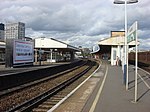Macmillan Cancer Support
1911 establishments in the United KingdomCancer organisations based in the United KingdomHealth charities in the United KingdomOrganizations established in 1911Palliative care in the United Kingdom ... and 1 more
Use British English from March 2016
Macmillan Cancer Support is one of the largest British charities and provides specialist health care, information and financial support to people affected by cancer. It also looks at the social, emotional and practical impact cancer can have, and campaigns for better cancer care. Macmillan Cancer Support's goal is to reach and improve the lives of everyone who has cancer in the UK.
Excerpt from the Wikipedia article Macmillan Cancer Support (License: CC BY-SA 3.0, Authors).Macmillan Cancer Support
Albert Embankment, London Vauxhall (London Borough of Lambeth)
Geographical coordinates (GPS) Address Nearby Places Show on map
Geographical coordinates (GPS)
| Latitude | Longitude |
|---|---|
| N 51.487940833333 ° | E -0.12318444444444 ° |
Address
Vauxhall Cross
Albert Embankment
SE1 7TP London, Vauxhall (London Borough of Lambeth)
England, United Kingdom
Open on Google Maps






